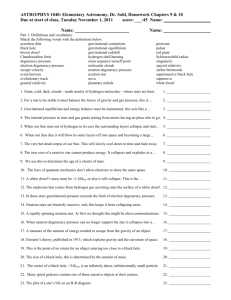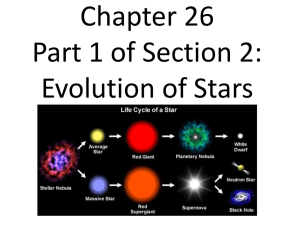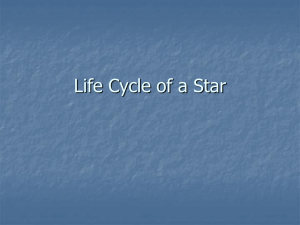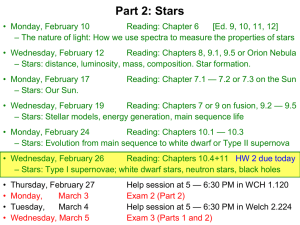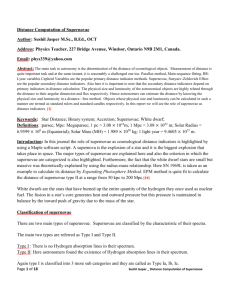Life Cycle of Stars Powerpoint ( Prentice Hall Ch 21, Sec. 3)
advertisement
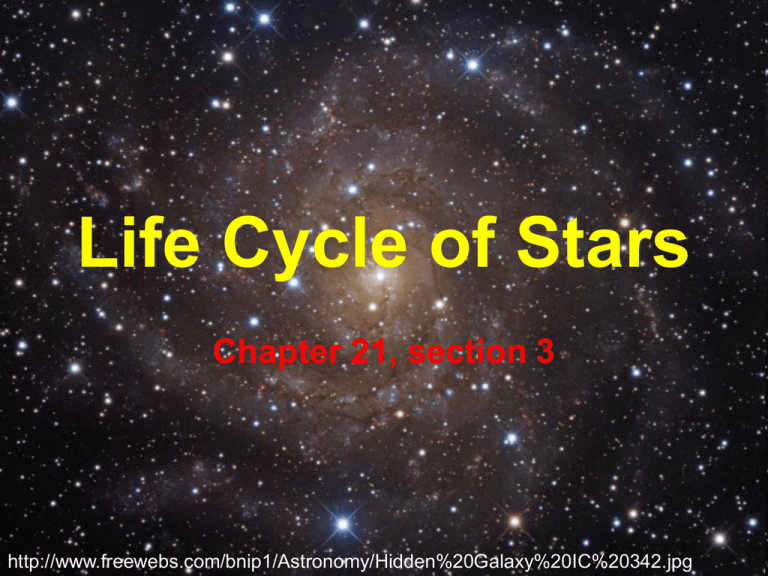
Life Cycle of Stars Chapter 21, section 3 http://www.freewebs.com/bnip1/Astronomy/Hidden%20Galaxy%20IC%20342.jpg Nebulas and protostars • A star is made up of a large amount of gas in a relatively small volume. • All stars begin as nebulas which are large amounts of gas and dust spread out over an immense (huge) volume. • Gravity can pull some of the gas and dust in a nebula together • This contracting cloud is called a protostar which is the earliest stage in the life of a star 2 Protostars Eagle Nebula http://feps.as.arizona.edu/outreach/ images/158286.JPG http://larvalsubjects.files.wordpress.com 3 Birth of a Star • A star is “born” when the contracting gas and dust become so hot that nuclear fusion begins to occur. • How long a star lives depends on how much mass it has. Stars with less mass burn their fuel more slowly and last longer than stars with more mass 4 Lifetimes of Stars • Stars with little mass can live as long as 200 billion years. • Stars that are 15 times bigger than the sun might last only 10 million years. • The sun is medium-sized and should live for about 10 billion years, since the sun is about 4.6 billion years old it is almost halfway through its lifetime. 5 Deaths of Stars • When a star begins to run out of fuel, the center of the star shrinks and the outer part expands. The star becomes a red giant or supergiant • All main sequence stars eventually become red giants or supergiants, what happens next depends on the mass of the star. • When a star runs out of fuel it becomes a white dwarf, a neutron star, or a black hole. 6 Life Cycle of a Star Small or Medium Star Black Dwarf Red Giant 1.Nebula/Protostar Giant or Supergiant Star Supernova Black Hole Nuetron Star 7 White Dwarfs • Small- and Medium-sized stars become red giants, then the outer layers drift off into space. The blue-white hot core is left behind and is a white dwarf. 8 and Black Dwarfs • A White dwarf has the mass of the sun but is the size of Earth, it is one million times as dense as the sun. When a white dwarf runs out of fuel and energy it becomes a black dwarf. • A black dwarf has stopped glowing because fusion has stopped. It is a “dead” star, not the Death Star that is Darth Vader’s spacecraft. 9 Neutron Stars • Dying giant or supergiant stars can explode, this is called a supernova. Left behind is an incredibly dense star called a neutron star, only about 20 kilometers across. • A spoonful of matter would have as much mass as a large truck 10 Black Holes • Only the most massive stars with 40 times the mass of the sun become black holes. • After a supernova more than 5 times the mass of the sun can be left. • The gravity is so strong that gas is pulled inward, eventually all of this mass is contained with in a sphere only 30 kilometers in diameter. 11 Black Holes • The gravity becomes so strong that nothing can escape, not even light. This is a black hole. • No light, radio waves, or any form of radiation can get out of a black hole. Astronomers can not see black holes directly. • Astronomers can detect black holes indirectly – Gas pulled in rotates so fast that it heats up and gives off X-rays – Scientists can calculate the mass of a black hole by it effect on nearby stars 12 Quasars • In the 1960’s astronomers discovered very bright objects that are very far away, about 12 billion light-years away • Astronomers concluded that quasars are distant galaxies, each with a black hole at its center 13 Medium-sized Star (The Sun) http://www.physics.uci.edu/%7Eobservat/SunPluto.jpg 14 Red Giants http://www.physics.uci.edu/%7Eobservat/ArcturusSun.jpg 15 Giants and Supergiants Supergiants Red giant http://www.physics.uci.edu/%7Eobservat/AntaresSun.jpg16 Supernova 17 http://www.orionsarm.com/tech/supernova3.jpg White Dwarf and Black Dwarf http://www.celestiamotherlode.net/catalog /images/screenshots/various/extrasolar_ stars_White_Dwarf_Sirius_B_1__ Frank_Gregorio.jpg http://www.tqnyc.org/2006/ 18 NYC063368//blackdwarf.gif Neutron Star 19 http://www.ph.ed.ac.uk/nuclear/photo/xray_neutronstar.jpg Black Hole http://www.nrao.edu/images/supermassiveBlackHoleRip510.jpg20 Quasar http://www.spacetoday.org/images/ DeepSpace/Quasars/Quasar3C273Hubble.jpg 21


